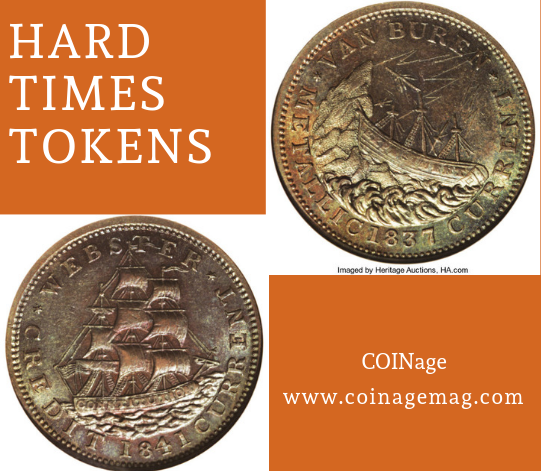
By David Schwager
If all the coins in circulation went away, would you make your own? More than once in American history, people took minting into their own hands. Hard Times tokens remain to tell the story of one of those episodes.
Some historians say that the Hard Times, an economic downturn of 1837-44, was as severe as the Great Depression of the 1930s—although, with economic statistics unavailable for the earlier period, we will never know for sure.
Earlier in the 1830s, the United States was prosperous, with wealth created by easy credit and speculation in newly settled frontier land. The Bank of the United States—a federally chartered, but privately owned institution—handled government funds, and its paper money was widely accepted at face value.
Private Producers Mint Coins to Fill a Gap
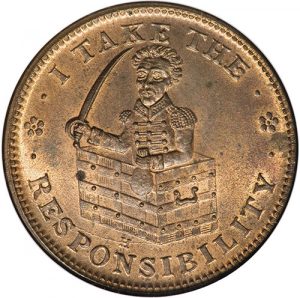
President Andrew Jackson, who served from 1829 to 1837, was a polarizing figure with ardent followers and fervent opponents. He favored hard money, preferring coin over paper, and felt that the Bank of the United States enriched its owners at the expense of average people and the taxpayers. In 1836, Jackson issued the Specie Circular, an order that federal lands would be sold only for gold or silver instead of banknotes or credit. At the same time, Jackson’s supporters allowed the charter of the Bank of the United States to expire. The bank closed peacefully and paid its depositors, but this further tightened credit.
These two changes lessened the money supply, causing business activity to dry up. The nation entered the period that became known as the Hard Times in 1837, as Jackson’s successor, former vice president Martin Van Buren, took office. Concerned people hoarded precious metal. Gold, then silver coins disappeared from circulation. Soon, even copper cents could not be found in the market.
With official coinage gone, private businesses stepped in to fill the void. Several companies with experience making medals, buttons, or other small metal objects began issuing copper tokens about the same size as the missing large cents. Storekeepers and other business owners bought these tokens in bulk at less than one cent each and then gave them to their customers in change at the value of one cent. Token makers earned profits for their work, merchants profited from the difference between purchase price and face value, and the general public profited by having coins for conducting their daily business. The results of this spontaneous market-based solution became known to collectors as Hard Times tokens.
Servings as Cent Substitutes
The great majority of Hard Times tokens show extensive wear, indicating that they served their intended purpose and circulated as money. Without the government or another agency to take worn tokens out of circulation, they continued to serve as cent substitutes for years afterwards, until the United States ended large cent production in 1857.
The end of the large cent marked the beginning of widespread coin collecting in the United States, and tokens, such as Hard Times tokens, were some of the most avidly collected pieces in the early days of American numismatics. Today, they attract the attention of many collectors who otherwise focus on federal coinage, and often appear in general references on U.S. coins.
Because Hard Times tokens were substitutes for those official coins, many resemble federal one-cent pieces. The makers used Liberty head, wreath and eagle motifs, changing them just enough to avoid accusations of counterfeiting. The reverses might have “NOT ONE CENT” or other wording close to the legends on official coins. As an example, the series includes a half cent token dated 1837, with an eagle similar to the one on silver Capped Bust coins on one side, a wreath similar to the one on half cents of the period on the other side, and the words “HALF CENT OF PURE COPPER”. Not only were these images similar enough to allow the tokens to circulate, but some coin collecting albums include a space for this token, as the mint made no 1837 half cents.
Counterfeit Cents in Circulation
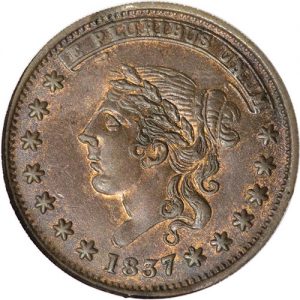
Sometimes, the changes were not enough, as in the case of prolific token producer William Scovill, of Scovill Manufacturing, who was indicted for counterfeiting in 1838. He was never brought to trial, and the legal action may have been prompted less by the company’s bogus pennies and more by their satirical and political tokens. These tokens were overtly political, usually attacks on Van Buren or Jackson.
Although the Hard Times began in 1837, collectors and researchers often group in tokens from as early as 1832, when similar pro-Jackson and anti-Jackson pieces began appearing.
One undated token shows Jackson emerging from a treasure chest holding a sword and a moneybag. The designer intended to show that it was dangerous for one person to hold both military and financial power. The donkey on the reverse, a common theme in anti-Jackson cartoons, further criticized the former president as stubborn and unrefined. (Jackson’s supporters eventually took the donkey label as their own, which is why the Democratic Party that Jackson founded still uses the donkey as its symbol today.)
Social Commentary Via Tokens
Another often-seen token depicts a wrecked ship with the legend “VAN BUREN METALLIC CURRENCY 1837” on one side, and a safely sailing ship and the words “WEBSTER CREDIT CURRENCY 1841” the other. (“Currency” sometimes appears as “current”, which had the same meaning at the time.) Supporters of the unsuccessful Whig Party candidate Daniel Webster, who lost the 1836 presidential election to Van Buren, made this token. “Times are tough with tight credit under Van Buren today in 1837,” they intended to say, “but when our man Webster is inaugurated in four years, we will have smooth sailing.” Webster decided not to run again, but the issuers were right that the Hard Times ended in the next administration, under John Tyler.
One of the most popular political tokens shows a kneeling slave with the legend “AM I NOT A WOMAN AND A SISTER 1838”. The general design comes from half penny tokens issued in Britain in the 1780s and ’90s opposing slavery in the British Caribbean colonies. Slavery and anti-slavery items of all types are highly collectible, and although not hard to find, this piece brings higher prices than other Hard Times tokens. A seldom-seen variety with a male slave and “AM I NOT A MAN AND A BROTHER” is one of the rarities of the Hard Times series, with three examples known.
The next class of tokens, which also includes rare types, had no connection to weighty social questions, but sought only to promote businesses. Known as store cards, each token bears an advertisement, allowing their issuers to give small change to current customers, while attracting new patrons. About 140 businesses advertised on store cards, including restaurants, clothing stores, manufacturers, and even token makers such as Scovill, mentioned earlier.
One of the most intriguing store cards came from a New York City pharmacist named Dr. Louis Feuchtwanger. He spent much of 1837 attempting to interest the United States Mint in using his nickel-copper-tin alloy (called Feuchtwanger’s Composition or American Silver) for one-cent coins. When this plan proved unsuccessful, he had probably millions of what later became known as Feuchtwanger Cents struck at his own expense and distributed into commerce. Although some store cards appear for sale frequently, others are quite rare and Hard Times specialists put much of their effort and money into finding tokens from scarce merchants.
Tokens Provide Affordable Collecting Option
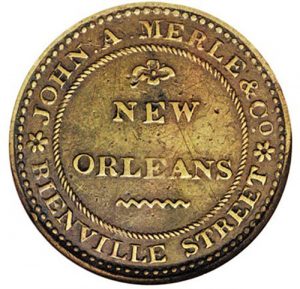
Before becoming a specialist, a collector needs to make a first purchase and explore a series. Hard Times tokens are easy to start collecting. Plenty of pieces exist with honest wear and no problems, and can be obtained at modest prices. A typical token grading Very Fine might sell for $15 to $30. One of the ship tokens described earlier makes a great first buy, and there are plenty of other options. Collectors like coins with stories, and most of the political tokens and imitation cents remain affordable while telling the story of the Hard Times.
A collector looking to spend a little more for a better piece as an initial purchase or seeking to upgrade their collection might consider one of the same political tokens certified in a lower mint state grade, such as MS-62 or MS-63. The most common varieties bring around $250. This compares favorably to the $750 or so a collector would have to pay for a much more common large cent of the same period in the same grade. A mint state political token is a good choice for the collector who wants only one piece to represent the entire Hard Times series. It’s an attractive token for a reasonable investment.
The collector wanting the scarcer pieces, less suitable for a first buy, will find that they often do not exist in mint state. There are too many rare merchants to list, but as an illustration, all 11 New Orleans issuers are hard to find, and most types have no uncirculated examples. Some of the least common merchants have only a few—sometimes only one—known pieces, and values can go into the high five-digit range. Rarer pieces will take more work and research to locate, and buyers should wait a year or longer after starting their collection.
After those first few purchases, you will have an idea of how you feel about Hard Times tokens and whether you want to continue. At this point, consider making a collecting plan. With so many scarce varieties, buying one of each is not practical. In fact, it has never been done. Instead, decide on a satisfying approach that works well for you. A type set collector might want one imitation cent, one political token, and one store card, or one of each category—however you choose to define those categories.
Explore Unique Sources of Tokens
One of the most common approaches is to buy as many different types as is practical, continually working toward expanding and improving the set instead of completing it. Some collectors find that one nice coin (or one extraordinary coin) is enough to represent Hard Times tokens in their holdings.
Where should one make those purchases? Hard Times tokens are not federal coins but, as money issued in the United States, they are just outside the main body of U.S. numismatics. They hold a position similar to that of colonial coins or Civil War tokens.
Unless they deal strictly in U.S. mint products, most mail order dealers or local coin shops will have a few. Consider starting with the same dealer you regularly patronize when buying your first few tokens.
When moving to uncirculated tokens or any but the most common store cards, the task quickly becomes more difficult; pieces are not necessarily expensive, but they are harder to find. A coin show becomes a better option, or consider contacting some of the larger mail order dealers about these. An advanced collector looking for scarce varieties or seldom-seen types will probably need to wait for the pieces to appear in major auctions.
Limited Recorded History of Hard Times Tokens
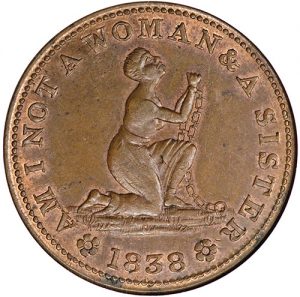
When studying Hard Times tokens, or tokens and medals of almost any type, you will notice that some of the information we take for granted in collecting United States Mint coins simply does not exist. The Mint kept careful records on how many coins of each type were made each year and where they were made, leaving only a few gaps to puzzle the researcher. With tokens, however, no mintage figures exist. The forward-looking nature of successful businesses means that records seldom survive more than a few years before being discarded. We do not even know for sure who made most Hard Times tokens.
Researchers have done extensive work tracing letters and design elements from one token to another to figure out the probable producer of many tokens, but few primary sources exist. This is another of the fascinating aspects and opportunities of numismatics: that so much research remains to be done and that dedicated amateurs add to the body of knowledge every year. To gain that knowledge, we follow the advice to “buy the books before buying the coins”.
Key References For Token Collecting
So what should those books be? If you plan to buy only a few low-cost tokens, you can get by with the three pages on the subject in A Guide Book of United States Coins, which most of us already own. This illustrates several types and gives a basic price guide. If you plan to explore the field in any depth, as a researcher or collector, the best reference is A Guide Book of Hard Times Tokens, by Q. David Bowers (2015). This book includes high-quality color photographs of every type, something seen in no other reference on the subject. A collector who continues with the series should also add Russell Rulau’s Standard Catalog of Hard Times Tokens, 9th Edition (2002). Although not as organized as the Bowers work, it gives additional information on die varieties and manufacturers. Lastly, if you want to see illustrations of and research on scarce tokens, go to the Stack’s Bowers Galleries website and download the free catalog from the landmark 2008 sale of the James E. Dice and M. Lamar Hicks collection.
While reading about Hard Times tokens or browsing auction listings, you will see “Low” numbers and “HT” numbers. Lyman Low wrote the first book about Hard Times tokens in 1899 and numbered the types roughly in the order in which he discovered them. In the 1980s, Russell Rulau combined Low’s work with the many new types found in the 20th century and renumbered the series with HT (Hard Times) numbers. Sales listings often mention both numbers. For example, the most common variety of the Jackson/treasure chest token described earlier appears as “Low-51, HT-70”.
“Common”, of course, means common in the context of the series. Few people put aside these tokens when they were new, and the pieces are only common in relation to the demand for this material at the edge of the numismatic mainstream. Rare does mean rare, however, and one of the attractions of Hard Times tokens or other fields outside of federal coinage is that scarce tokens sell for a fraction of what a United States Mint coin of the same rarity would bring. A mid-budget collector with the right education and patience can put together a fine collection.















I very delighted to find this internet site on bing, just what I was searching for as well saved to fav
We just wanted to take a moment to acknowledge all the hard work and effort you’ve been putting in lately. Keep up the amazing job, you’re doing great!
I love how this blog gives a voice to important social and political issues It’s important to use your platform for good, and you do that flawlessly
This post came at just the right time for me Your words have provided me with much-needed motivation and inspiration Thank you